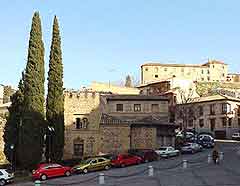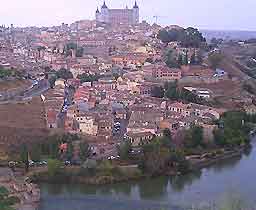Getting Around, Toledo Travel, Transport and Car Rental
(Toledo, Castile-La Mancha, Spain)

Toledo is a very easy city to get around, although the streets can be a little bit like a maze at times. The centre is fairly compact and most of the sights are within walking distance of one another. Much of Toledo is pedestrianised and if you are in the compact city centre there are many ways to travel in and around Toledo.
Buses
Galiano Continental buses run every 30 minutes and connect Toledo with
Madrid. The buses start at 06:00 and run until 22:00, and later on Sunday and public holidays. There are also several other buses run by different companies that travel to the surrounding towns and villages near to Toledo, such as Orgaz, Alcázar de San Juan and La Puebla de Montalban.
Trains
Toledo train station was built in 1920 and is an attractive feature of the city. There are usually 10 trains that travel to Madrid Cercanias train station and these are a pleasant and quick way to travel. The first train leaves Madrid at 07:20 and the last train departs at 08:45.

Car Rental
The N-401 is a main road that links Toledo with Madrid. When travelling south, you can also take the same road to Ciudad Real, which becomes the N-420 to Cordoba. The N-403 heads north-west of Toledo and towards Avila, and then continues to Salamanca.
Rules of the Road
- Citizens of EU member countries require a national driving licence to drive cars in Spain
- Citizens from non-EU member countries need an International Driving Permit, as well as their national driving licence
- You must be at least 18 years old to drive a car in Spain and have a valid driving licence and car insurance
- It is compulsory for the driver and all passengers to wear seat belts and children under 14 years old are not allowed to travel in front seats
- In Spain, cars drive on the right-hand side of the road
- Give way to traffic coming from the right at junctions and roundabouts
- Many Spanish motorists drive fast and brake late, so use extreme caution when approaching traffic lights and junctions if you are being followed
- Avoid driving in the city's rush hours, which are generally between 07:00 to 09:30 and 16:30 to 19:30
- There is an extensive network of major routes that connect Madrid to the nation's cities
- Six roads lead directly to and from Madrid. They are numbered in Roman numerals N-I to N-VI and are connected by the M-30 or M-40 ring road
- Beware of what appear to be shortcuts on maps - these often turn out to be unpaved roads or mountain passes
- Spanish fuel stations supply most internationally known brands of unleaded petrol (gasolina sin plomo) and diesel (gas oil)
- In rural areas, there are normally only a few service stations, so when travelling long distances, be sure to leave with a full tank of fuel
- Autopistas (toll motorways) have various toll charges calculated by the kilometre and some roads that lead into cities also have fixed toll charges
- 75 miles per hour / 120 km per hour is the national speed limit on motorways (autopistas) and 62 miles per hour / 100 km per hour is the maximum limit on autovias with four or more lanes or three-lane highways
- Unless indicated, other major routes are 56 miles per hour / 90 km per hour and slower speed limits of 30 miles per hour / 50 km per hour are enforced in urban areas
- It is an offence not to carry some form of identification, such as passport or driving licence
Taxis
There is a taxi rank that is located near to Zocodover in the shadow of the Alcázar and another at the estación de autobuses. Alternatively, you can book Toledo taxis by phone.
By Foot
Probably the best way to explore the city of Toledo is on foot. It is well pedestrianised and walking provides one of the best ways to fully appreciate the character of the city.
 Toledo is a very easy city to get around, although the streets can be a little bit like a maze at times. The centre is fairly compact and most of the sights are within walking distance of one another. Much of Toledo is pedestrianised and if you are in the compact city centre there are many ways to travel in and around Toledo.
Toledo is a very easy city to get around, although the streets can be a little bit like a maze at times. The centre is fairly compact and most of the sights are within walking distance of one another. Much of Toledo is pedestrianised and if you are in the compact city centre there are many ways to travel in and around Toledo.